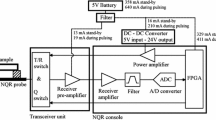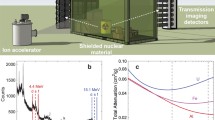Abstract
Nuclear quadrupole resonance (NQR) of14N nuclei has many advantages as a method for detecting nitrogen-containing explosives, the most important are very high chemical specificity, true noninvasive operation and detection of bulk explosive in situ only (no vapor or particular capture needed). One of the most high explosives is hexogen (RDX) often used by terrorists in plasticized forms. The ring nitrogen nuclei in an RDX molecule generate three sets of NQR frequencies corresponding to three physically nonequivalent positions of the molecule in the crystal lattice. The prototype device we have constructed is intended for inspection of suitcases for the presence of plastic explosives containing RDX or octogen by14N quadrupole resonance. It is essentially a fully automated PC-controlled pulsed FT NQR spectrometer equipped with a large volume (70 1) radio-frequency (RF) sample coil to accommodate a typical suitcase. The device consists of a measure chamber with an RF coil, tuning and matching box, an RF pulse transmitter and a control PC with dedicated cards like digital receiver, frequency synthesizer, pulse programmer and probe-tuning controller. The control software finds the NQR lines and measures their frequencies. An alarm is produced if any of these frequencies matches the characteristic NQR frequency of the explosive and the signal-tonoise ratio exceeds the preset threshold. Multipulse sequences of the type SORC (strong off-resonance comb) or SLSE (spin-locked spin echo) were used in order to increase the allowed data acquisition rate. We could detect 230 g of PMW-8, a plastic explosive (containing 81% of RDX) in 10 s or 100 g in 30 s. Detection probability was not less than 90%.
Similar content being viewed by others
References
Smith J.A.S.: Chem. Soc. Rev.15, 225 (1976)
Grechishkin V.S.: Appl. Phys. A55, 505 (1992)
Garroway A.N., Buess M.L., Yesinowski J.P., Miller J.B.: SPIE Substance Detection Systems2092, 318 (1993)
Garroway A.N., Buess M.L., Yesinowski J.P., Miller J.B., Krauss R.A.: SPIE Cargo Inspection Technologies2276, 142 (1994)
Garroway A.N., Buess M.L., Miller J.B., McGrath K.J., Yesinowski J.P., Suits B.H., Miller G.R., in: Nuclear Quadrupole Resonance (NQR) for Detection of Explosives and Landmines. Proceedings of the 6 International Symposium on Analysis and Detection of Explosives, Prague, Czech Republic, 6–10 July 1998 (Mostak P., ed.), chap. 19. Pardubice-Semtin: Research Institute of Industrial Chemistry 1999.
Ostafin M., Mackowiak M., Bojarski M.: Z. Naturforsch.49a, 42 (1994)
Author information
Authors and Affiliations
Rights and permissions
About this article
Cite this article
Ostafin, M., Nogaj, B. Detection of plastic explosives in luggage with14N nuclear quadrupole resonance spectroscopy. Appl. Magn. Reson. 19, 571–578 (2000). https://doi.org/10.1007/BF03162402
Received:
Revised:
Issue Date:
DOI: https://doi.org/10.1007/BF03162402




